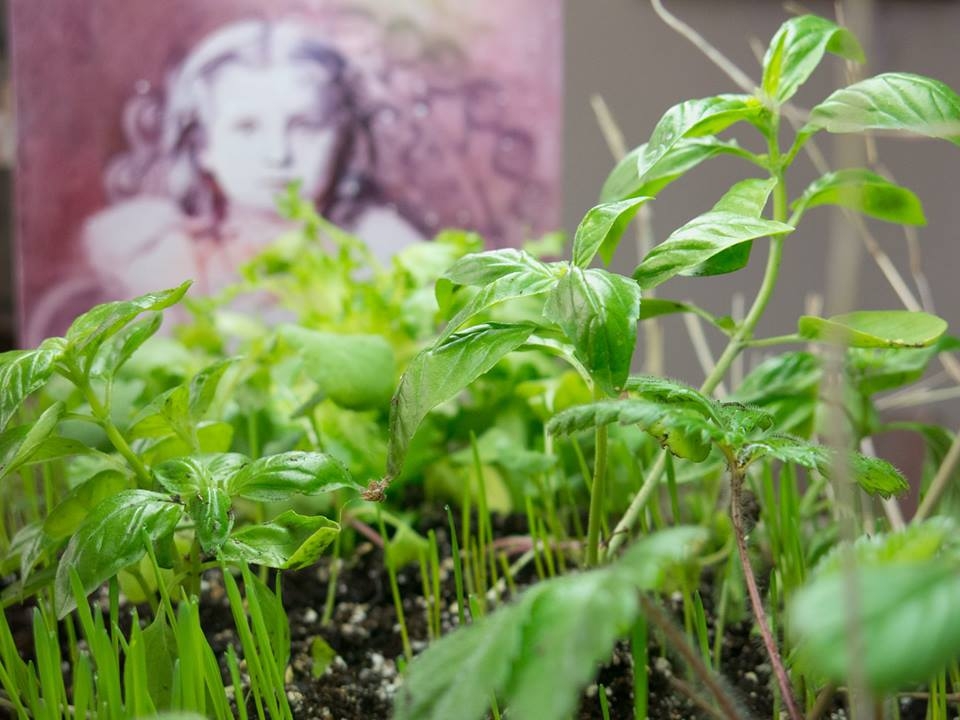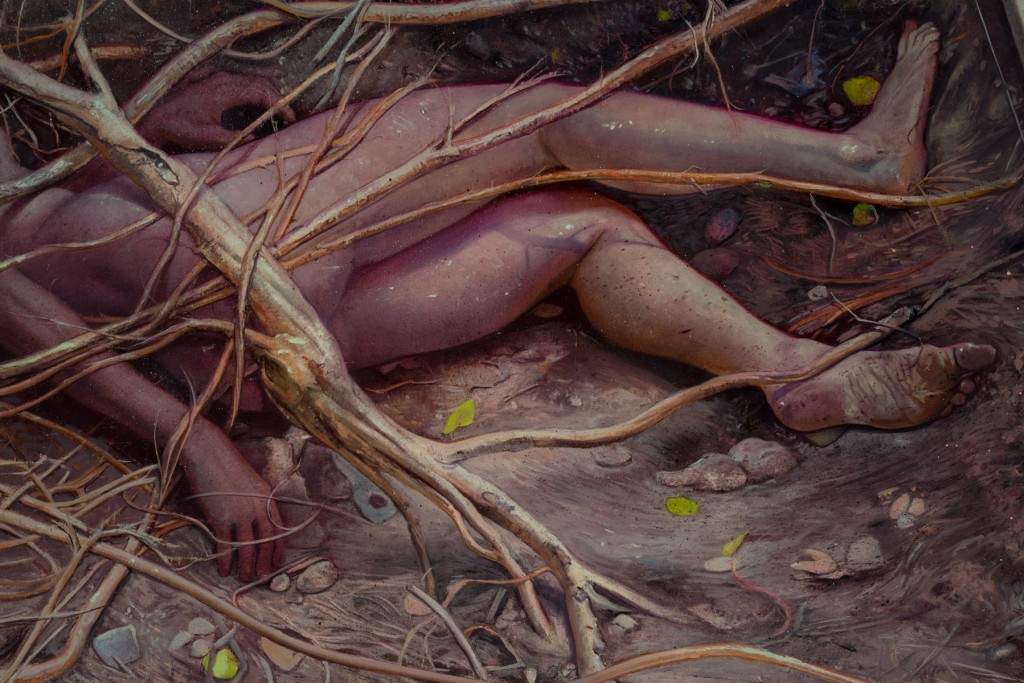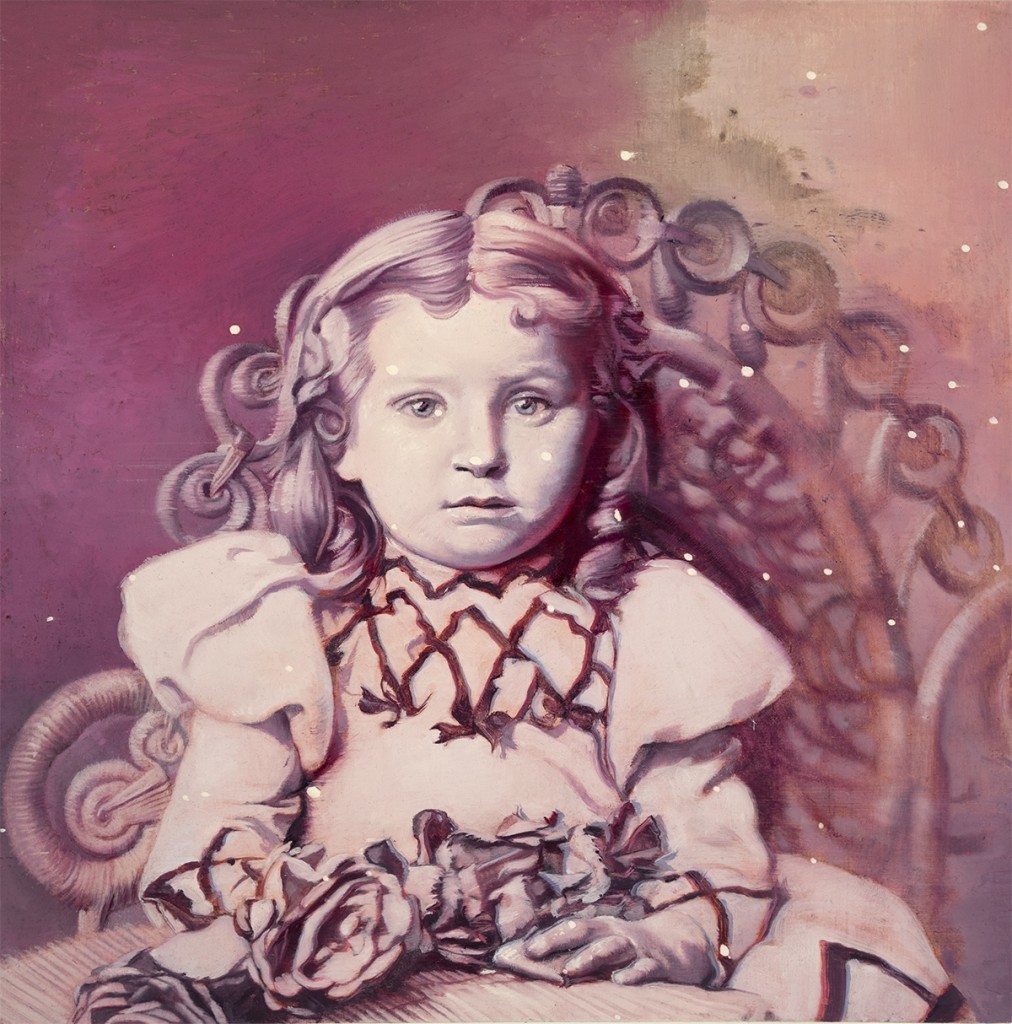Keith Schweitzer of ART(inter) in conversation with NY-based artist Melanie Vote.

Melanie Vote, Place Like Home (2008-16, oil on linen on panel, 26″x18″)
KS: I’ve long admired your fresh take on a rather old fashioned artistic practice: plein air painting. How much of your work is painted outdoors? What is it about plein air painting that appeals to you?
MV: For this show at Hionas Gallery there will only be one or two pieces that have, in part, been painted plein air. Both are part still-life, as well. One small piece, Posted II, began last summer while visiting a writer friend’s overgrown farm. The piece was created while sitting in the shade, painting the long un-mown grass during afternoons over a few consecutive days, and then painting a small Kewpie doll atop of a sign afterwards, indoors. I included this exact same sign in a painting a few years earlier, while it was attached to tree near the property. The land became public, and when my friend heard of this she took the sign down and gave it to me as welcoming gift upon my next visit.
As do most people, I love being outside in the summer. I grow restless, cooped-up in the studio on warm summer days knowing those moments are fleeting. I grew up in rural Iowa and first painted outside to reconnect with the landscapes of my childhood after living in NY for about a decade. Painting outdoors creates a sense of urgency, it pressures me to focus in a way that painting inside rarely does. These faster, more energetic paintings then inform my studio paintings.
KS: You employ a number of unusual practices to develop your works. You’ve cast your childhood toys in plaster, you’ve buried objects, you’ve excavated sites…
MV: Yes, all of this is part of my visual research process. Sometimes I have only a feeling of what I am after visually, and even if I think I know what I wish to achieve, that changes with outcomes that present themselves.
Now I am in the process of creating a “Growing Bed” for the show. It too will become a part of a painting, or inform some future studio piece somehow.

Installation detail, Overgrowth, Hionas Gallery
KS: Your upcoming exhibition at Hionas Gallery, Overgrowth, is an ambitious and immersive installation, an experiential journey through your introspections during the years following your mother’s passing in 2010. When announcing the show, you quoted a passage by American poet Mary Oliver: “To live in this world / you must be able / to do three things: / to love what is mortal; / to hold it / against your bones knowing / your own life depends on it; / and, when the time comes to let it go, / to let it go.” This is a deeply personal exhibition. Please tell us a bit about the works in the show.
MV: Each time I read this passage, along with most of Oliver’s poetry, a certain realness comes over me that brings me to a near-tears awake sort of place.
All the works in the exhibition are a confrontation of mortality in an aim to reconcile a struggle with impermanence, and they are created to relate to the cornerstone piece, Excavation of Life and Death, which will be seen in the last room of gallery.

Melanie Vote, Excavation of Life and Death (Detail), (2016, oil on canvas, 84″x102″)
The first room of the gallery will be transformed to look like a small bedroom, slightly amiss. Upon entering one will first be confronted with a sculptural bed, containing live plants taking over a mattress. Two paintings—Rhapsody in Magenta and Violet, a celebratory portrait of an unknown girl, and Night Visitor, a trompe l’oeil window with a frog seen peering in from the darkness—will both be hung on a stenciled wallpaper-like pattern foreshadowing the painting in the next room, Place Like Home.

Melanie Vote, Rhapsody in Magenta and Violet (2016, oil on linen, 10″x10″)
This piece was started in 2008 and is one of two versions. The one finished in 2008 was Girl With Cucumbers. It was an ironic take on the same subject matter. This one new piece was set aside until last year. It was recently finished and embodies the present transformation of self.
KS: I understand that the larger paintings in the show started out as a raw canvas floor covering, originally used to hide some unsightly flooring in your apartment. How did this transformation take place?
MV: After about six months of grief following my mother’s death, I decided to create a sort of calming sanctuary in my room. Part of the floor I’d covered with rugs, but still about half had a typical 1970’s looking faux something that was rather visually accosting—linoleum sticky tile, not exactly ideal for a bedroom. Actually, the room was originally designed to be the apartment’s dining room long before I took up residence. I searched, without success, for an inexpensive floor covering. Still seeking a simple solution, I thought to make a floor cloth from canvas gessoed on both sides, which worked out well. Then, after about four years, I moved out and had this enormous surface. I never really thought to paint so large, but it seemed it was just there, almost created unknowingly for this piece.
The heavy subject matter and size have been a big undertaking.
I came to the initial image of myself in a shallow grave inadvertently. In 2011 I carefully staged a faux excavation site, where I buried an artificial artifact, then painstakingly documented myself ‘finding’ a large toy sculptural head. I wasn’t completely satisfied with the images, so I climbed down into the void and took pictures of myself laying there.
It took me over three years to feel distant enough from the loss of my mother to have the courage to begin this piece. Even after that amount of time passed it was still difficult at moments to face daily in the studio.

Melanie Vote, Excavation of Life and Death (2016, oil on canvas, 84″x102″)
The dots came in to give the piece some visual levity while researching games with a class I teach. First I painted in highly chromatic Twister-matt tones, then it got lighter and lighter, and the body of the figure eventually became darker to group with the soil. It’s gone through seemingly endless changes, but finally as I was bringing it to a close my father—a person of 73 years who has seen plenty of loss and endured many challenges in this lifetime—presented this question: What is the best way to eat an elephant? Answer: One bite at a time.
I believe I’ve finished the elephant, well at least this one.
View more of Melanie Vote’s artwork on Instagram: @melanievote. Her upcoming solo exhibition at Hionas Gallery (124 Forsyth Street New York, NY 10002) opens Thursday, March 17th (6-8pm) and runs through April 17th.
Keith Schweitzer is a New York City based arts organizer, curator and producer. He is Co-Founder/Director of The Lodge Gallery, located on Manhattan’s Lower East Side. He is also Director of Public Art for Fourth Arts Block, the nonprofit leadership organization for Manhattan’s officially designated Cultural District in the East Village. You can find him on Twitter as @Keith5chweitzer, and on Instagram as @pseudohaiku.

[…] interview originally appeared on ART[inter]. It has been updated and republished […]